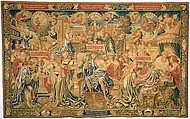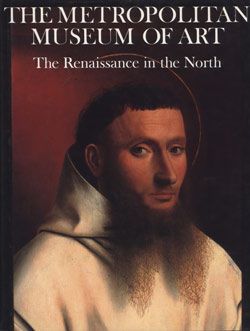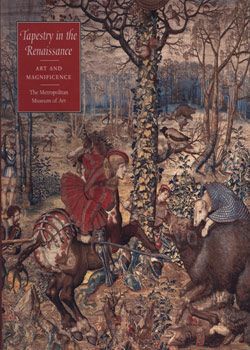The Twelve Ages of a Man: The Last Three Ages (54-72), or Winter
Probably after a design by the Workshop of Bernard van Orley Netherlandish
Not on view
This is the fourth in a set of four tapestries illustrating the life of a man as divided into twelve periods of six years. Aeolus, ruler of the winds, in the center, stands for the wintertime of life. The symbols and occupations of three months, October, November, and December, represent the years from ages 54 to 72, traditionally identified as the final three ages of a man, equated with old age, infirmity and death. Aeolus’s two attendants may be personifications of Snow and Frost. The owl symbolizes sleep and death.
Each of the three vertical sections includes a roundel at the top surrounded by twenty-four hourglasses on a ground that is light above and dark below, in varied proportions, according to the seasons. Each roundel contains a sign of the zodiac, Scorpio, Sagittarius and Capricorn, and a figure variously symbolizing October, November or December. Flanking the roundels are embodiments of wintery winds, mostly with their names inscribed on their bellows or elsewhere, amongst them is Boreas, himself often the symbolic embodiment of winter. Beneath, as appropriate occupation of the month, pigs are fed under October and threshing and winnowing represent December (not, in fact, a usual activity for this month and probably included to allude to the accompanying inscription "The Goat shakes the grain from the fallen ears"). Below are episodes from classical history and the Old Testament illustrating protagonists associated with particular ages of a man. For Old Age (54-60), the piety of the Byzantine Emperor Tiberius II is rewarded when he causes a paving stone inappropriately bearing the cross to be lifted and discovers treasure, which he distributes amongst the poor. For Infirmity (60-66), Tobias respectfully listens to the parting advice from his blind and infirm father, Tobit. For encroaching Death (66-72), Jacob blesses his grandsons Manasseh and Ephraim from his deathbed. Perhaps indicating the possible patron of this tapestry series, the empress in Tiberius’s scene has the facial features of Margaret of Austria, Governor of the Habsburg Netherlands; the man standing behind her repeats a figure representing Saint Gommaire in a stained-glass window (now in the Royal Museum of Art and History in Brussels) made for the chapel of the Fencers' Guild in Mechelen cathedral, probably a disguised portrait of a noble member of the guild and Margaret's court.
The two outer episodes have framed pairs of verses in Latin, supported by pedestals, between them and the occupation of the month above; the center episode has a similar inscription between it and the deity below. The verses refer to the story illustrated. In the upper border, on scrolls held by winged boys, are three Latin couplets connecting each month with an age in the life of man. In the lower border, flanking the inscription below the deity, are two medallions containing an animal, bird or object. The foregrounds of all the scenes are filled with flowering and fruiting plants.
Due to rights restrictions, this image cannot be enlarged, viewed at full screen, or downloaded.





